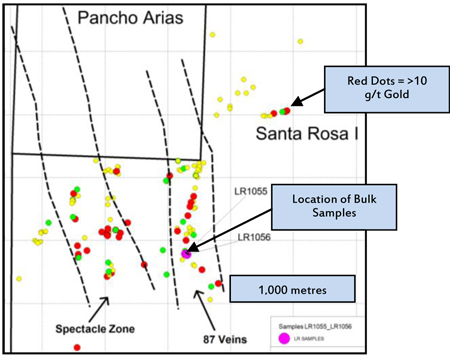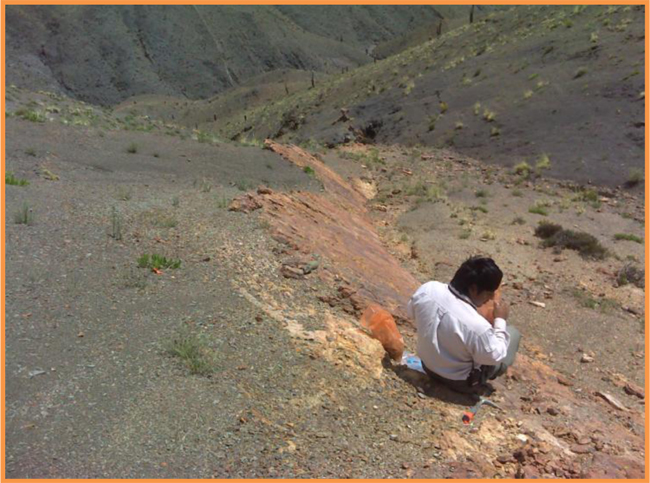Salta Exploraciones S.A. (Salta), Cascadero's 50% owned Argentine subsidiary, has received assays from two bulk samples from the 87 Vein, which is part of a north trending gold bearing structural and alteration corridor peripheral to the south and continues through the eastern part and to the north of Salta's recently drilled Pancho Arias high-grade molybdenum deposit. Salta holds a 100% interest in the Santa Rosa property. The program was operated by Salta personnel and designed and supervised by Raul Chocobar, Vice-President of Exploration and a director of Salta.
SANTA ROSA BULK SAMPLE ASSAY RESULTS
PANCHO ARIAS MINERAL DISTRICT
| Sample ID | Sample Weight Kgs | Gold g/t Fire Assay Avg of 4 samples | Silver g/t ICP Avg of 4 samples | Copper PPM ICP Avg of 4 samples | Lead PPM ICP Avg of 4 Samples | Zinc PPM ICP Avg of 4 Samples |
|---|---|---|---|---|---|---|
| LR1055 | 13.3 | 43.8 g/t (1.41 oz/t) | >100 g/t (3 oz/t) | 690 (0.069%) | >10,000 (>1.00%) | 2,650 (0.265%) |
| LR1056 | 16.3 | 35.2 g/t (1.13 oz/t) | 37.2 g/t (1.20 oz/t) | 697 (0.069%) | >10,000 (>1.00%) | 2,804 (0.280%) |
MAP ONE below shows the relative location of the Spectacle Zone and the 87 Vein corridor that adjoin Pancho Arias to the south and southeast. The 87 Vein corridor starts on the Pancho porphyry and extends to the south east onto the Santa Rosa claim. The Santa Rosa claim adjoins Salta's Pancho Arias high-grade molybdenum discovery to the south, east and north. Salta has taken over 200 rock chip samples from Santa Rosa, which define an area of fractures and veins in two zones, the Spectacle Zone and the 87 Vein corridor, to the south of the Pancho porphyry.
The 87 Vein corridor trends north south, dips from near vertical to 30 to 40 degrees to the east and is defined by geochemistry and outcrop for 1,200 metres to the south of the Pancho porphyry. The width of the 87 Vein mineralized and high-sulphidation altered corridor is about 50 metres and is comprised of veins up to 50 cm thick with several sub-parallel veins and fractures.
The Spectacle Zone is northwest of the 87 Vein and trends NNE towards the southwest corner of the Pancho Arias porphyry. The veins and fractures that outcrop on the Spectacle zone are similar to the 87 Vein corridor and are hosted in the same metasediments. Salta took 64 rock chip samples from the Spectacle Zone and 15 of those ranged from 30.6 g/t gold to 52.2 g/t gold. The Spectacle Zone are about 25 cm to greater than 50 cm thick with envelopes of argillic alteration that extend up to 50 cm into the wall rock on both sides of the quartz. The Spectacle Zone is significantly wider, up to 500 metres, than the 87 Vein corridor. In most instances the veins are visible due to their silica content and its resistance to weathering. In some areas the veins are fairly closely spaced at about 5 to 25 metres apart and between the large veins small pieces of quartz float are found indicating that smaller veins and fractures may be present in these recessive areas.
As displayed in MAP ONE, the geochemical pattern of this area presents the Spectacle Zone and the 87 Vein
corridor as two discrete mineralized zones related to regional and local structural controls, which are present in the Pancho multi-phase porphyry. The mineralization and alteration in these two zones are common and are a late stage event of hydrothermal highly evolved silica and metal rich fluids that are from the Pancho Arias porphyry system. The gold-silver-base metal mineralization is present in quartz-limonite-hematite veins and usually parallels foliation of the host rocks, which is also common to the two zones. As noted in TABLE ONE, the 87 Vein bulk samples have associated good grades of base metals as do the samples from the Spectacle Zone. Bismuth and arsenic are elevated to anomalous in most samples from both zones.
LOCATION 87 VEIN - SPECTACLE Zone
DEFINED BY GEOCHEMISTRY

Further work, by excavator trenching, is required to determine if the two zones of high-grade gold are possibly one zone that could be 1,200 metres east west by 1,200 metres north south. This possibility would present an open pit target whose value would depend on grade-over-width as the density and grade of the veins and fractures would determine viability. As noted, copper and gold grades were low in the recently drilled high-grade moly Pancho porphyry. The importance of locating a gold bearing zone with potential for grade and volume close to Pancho can't be understated. There are no drill holes in the 87 Vein or the Spectacle Zone. Assaying was done by ACME Laboratory, Vancouver BC.
SALTA PERSONNEL TAKING 87 VEIN BULK SAMPLES
Bill McWilliam
CEO
Email: bill@cascadero.com
Cell: 604-999-0391
ABOUT CASCADERO COPPER
Cascadero Copper is an integrated prospecting and mineral exploration business with offices in North Vancouver, BC, Canada, Sudbury, Ontario, Canada and Salta City in the province of Salta, Republic of Argentina. The Company generates, acquires and explores mineral properties and is active in the three jurisdictions. In north central British Columbia, the Company has a 100% interest in a 31,000 hectare property in the Toodoggone region, which is prospective for copper gold porphyry systems. This property is subject to a C$20 million Joint Venture with Gold Fields.
In Ontario, the Company holds or has the right to acquire a 100% in 17 properties in the Sudbury, Swayze and Timmins camps, which are volcanic and sediment hosted copper gold prospects.
In north western Argentina, the Company holds a 50% interest in a 46 property portfolio, which consists mainly of bulk mineable copper-moly-gold porphyries and bulk mineable sediment hosted silver-gold plus base and rare metals.
Cascadero's commodity focus is gold, silver, moly, copper, base and rare metal hosted in large-scale bulk mineable mineral systems.
In 2009, the Company discovered Taron, a large bulk mineable sediment hosted epithermal rare metal deposit in Argentina. In 2011, Cascadero discovered Las Burras, a new Argentine Cu-Mo-Au porphyry.
The Company holds a large claim block that adjoins Lumina Copper's Taca Bajo Cu-Mo-Au 1.762 billion tonne deposit. Several copper and gold showings exist on these claims. A first stage geochemical program is complete.
In 2012 to 2013, Cascadero intends to conduct exploration in three core areas: Pancho Arias Cu-Mo-Au porphyry District, the Taca Taca Mineral District and the bulk mineable sediment hosted silver prospects in the El Oculto District. Exploration is also planned for Taron, an exciting large-scale sediment hosted rare metal discovery.
Allan or Janice Feldman at AJF Consultants:
1207 Beach Grove Road, Tsawwassen, BC
Office = 604-948-9663 Cell = 604-377-2942
Neither the TSX Venture Exchange nor its Regulation Service Provider accepts responsibility for the adequacy or accuracy of this release.
